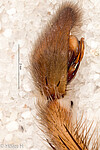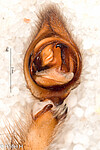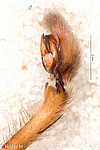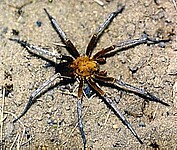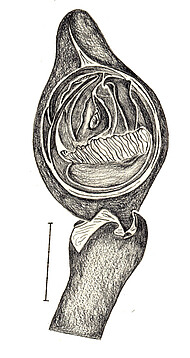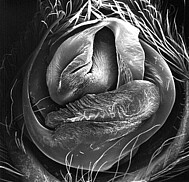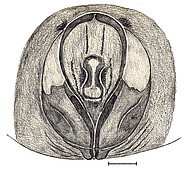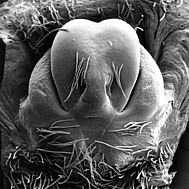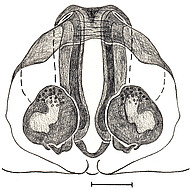Ancylometes terrenus (♂,♀) Höfer & Brescovit, 2000
distribution
Amazonas and Mato Grosso, Brazil.
description male
(Holotype deposited at INPA):
Prosoma purpurish to golden-brown with obscured broad marginal bands (appearing in alcohol material). Abdomen dorsally dark brown, cardiac mark lighter. Venter with bright red triangle, broken by median longitudinal dark line. Legs brown, femora dorsally purpurish-red to brown with prolateral white stripes, all distal segments dorsally covered by white hairs. Chelicerae with 3 promarginal and 4 equal sized retromarginal teeth.
Palpal tibia with curved ventral and black lateral apophysis. Embolus with very large, rectangular transparent membrane at base, occupying whole basal part of bulbus and covering base of evenly shaped, broad trunk of median apophysis.
Measurements: Total length 25.0. Prosoma 13.5 long, 11.0 wide. Clypeus 0.75.
Eye diameters and interdistances: AME 0.55, ALE 0.35, PME 0.6, PLE 0.6; AME-AME 0.35, AME-ALE 0.45, PME-PME 0.3, PME-PLE 0.55, AME-PLE 0.9, AME-PME 0.2, MOQ length 1.4, front width 1.4, back width 1.45. Cymbium 4.5 long, 2.8 wide, median apophysis 1.3 long (visible part).
Legs: I-femur 13.5/ patella 6.2/ tibia 14.0/ metatarsus 12.2/ tarsus 6.7/ total 54.0; II- 13.0/ 6.2/ 11.0/ 11.7/ 5.7/ 48.0; III- 11.8/ 5.0/ 10.2/ 11.3/ 4.5/ 42.0; IV- 16.0/ 5.7/ 13.3/ 17.2/ 6.0/ 63.0.
Leg spination: femora I p1-1-1, r1-1-1, d1-1-1; II p1-1-1-1, r1-1-1, d1-1-1; III p1-1-1-1, r1-1-1-1, d1-1-1; IV p1-1-1, r1-1, d1-1-1; tibiae I-II v2-2-2-2, p1-1, r1-1, d1-1 (I), 1-1-1 (II); III-IV v2-2-2, p1-1, r1-1, d1-1-1; metatarsi I-II v2-2-2, p1-1-1, r1-1-1, d0 (I), d1 (II); III v1-1-1-1-2, IV v1-1-1-1-1-2; III-IV p1-1-1, r1-1-1, d1-2-2; tarsi III-IV v4-10. Palpal femora p1, r1, d1-1-2; patellae p1; tibiae p1-1-1, r1.
description female
(Paratype deposited at SMNK 437):
Prosoma brown, covered by white and purpurish hairs. Chelicerae with 3 promarginal and 4 equal sized retromarginal teeth. Abdomen dorsally reddish brown, ventrally with bright red triangle from the epigastric region to spinnerets, divided by central longitudinal dark band.
Epigyne: Median plate drop-shaped, flat with a median cavity ending posteriorly in a prominent knob. Copulatory ducts long, straight and narrow. Spermathecae relatively large and wide apart.
Measurements: Total length 26.0. Prosoma 13.3 long, 11.6 wide. Clypeus 0.95. Eye diameters and interdistances: AME 0.52, ALE 0.3, PME 0.55, PLE 0.55; AME-AME 0.35, AME-ALE 0.6, PME-PME 0.3, PME-PLE 0.75, AME-PLE 1.3, AME-PME 0.35, MOQ length 1.6, front width 1.4, back width 1.45.
Epigynal median plate 1.8 long, 1.0 wide.
Legs: I-femur 13.0/ patella 6.5/ tibia 10.8/ metatarsus 9.3/ tarsus 5.0/ total 45.0; II- 11.5/ 6.2/ 9.5/ 8.8/ 5.0/ 42.0; III- 10.5/ 5.2/ 8.7/ 9.2/ 4.5/ 37.5; IV- 13.5/ 5.5/ 11.0/ 14.3/ 5.5/ 50.0.
Leg spination: femora I p1-1, d1-1; II p1-1, d1-1-1; III-IV p1-1, r1-1, d1-1-1; patellae III-IV p1, r1; tibiae I-II v2-2-2-2-2; III v2-2-2-(2-2), p1-1-1, r1-1-1, d1-1(2)-1; IV v2-2-2, p1-1, r1-1, d1-1-1; metatarsi I-II v2-2-1, p1, r1; III v1-1-1-1-2, p1-1-1, r1-1-1, d1-2; IV v1-1-1-1-1, p1-1-1-1, r1-1-1, d1-1-1-2; tarsi III-IV v5-7. Palpal femora p1, r1, d1-2; patellae p1; tibiae p2, r1; tarsi p2-1, r1.
references
- Höfer H., Brescovit AD. (2000):
- A revision of the Neotropical spider genus Ancylometes Bertkau (Araneae: Pisauridae). Insect Systematics & Evolution 31


